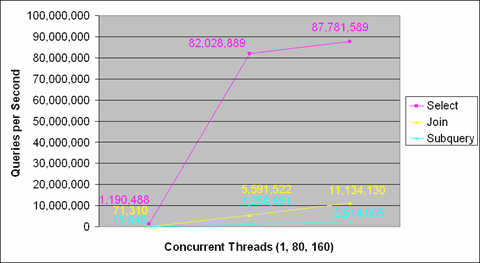- | Home |
- Company |
- Contact |
- News |
- S/ware Eng |
- Standards |
- Academic Support |
- Documents |

- | Requirements |
- Compilers |
- Validation |
- RTOS |
- Analysis |
- Hardware |
- Software |
- Resources |
- Products |
eXtremeDB-64: McObject’s 64-bit Embedded Database

Certain application types must rapidly process large volumes of data. Examples include business intelligence software that sifts competitive, economic and operational data; telecommunications systems that navigate a massive customer account databases; and scientific applications testing new compounds in silicon in the race to discover the next blockbuster drug
Figure 1. Benchmark test performed using eXtremeDB-64 for Linux running on 160 core SGI Altix server, 1.1 terabyte database
McObject’s eXtremeDB-64 in-memory embedded database provides the real-time 64-bit processing to greatly accelerate sorting, retrieving and analysing with very large data stores.
In addition to the in-memory database system (IMDS) version, eXtremeDB-64 is available as a hybrid embedded 64-bit database, called eXtremeDB-64 Fusion, that enables developers to combine all-in-memory with on-disk data storage in the same application. For details on the hybrid capabilities of eXtremeDB-64 Fusion, see this site’s page for the eXtremeDB Fusion product.
Compared to traditional 32-bit processors, 64-bit technology approximately doubles the amount of data a CPU can handle per clock cycle, and increases the amount of memory a system can address, from approximately 3GB, to more than one terabyte (1000GB).
With eXtremeDB-64, McObject moves to the forefront of embedded databases in providing 64-bit support. Other 64-bit databases (both in-memory and on-disk) are client-server products that entail separate database server and client application processes. In contrast, as an embedded database, eXtremeDB is a library that is linked with the client application. This eliminates client/server inter-process communication latency, providing eXtremeDB-64 with another significant performance advantage.
Consider the eXtremeDB-64 benchmark results from a test involving a very large database(VLDB), shown in Figure 1 that we feel merit the term “extraordinary
